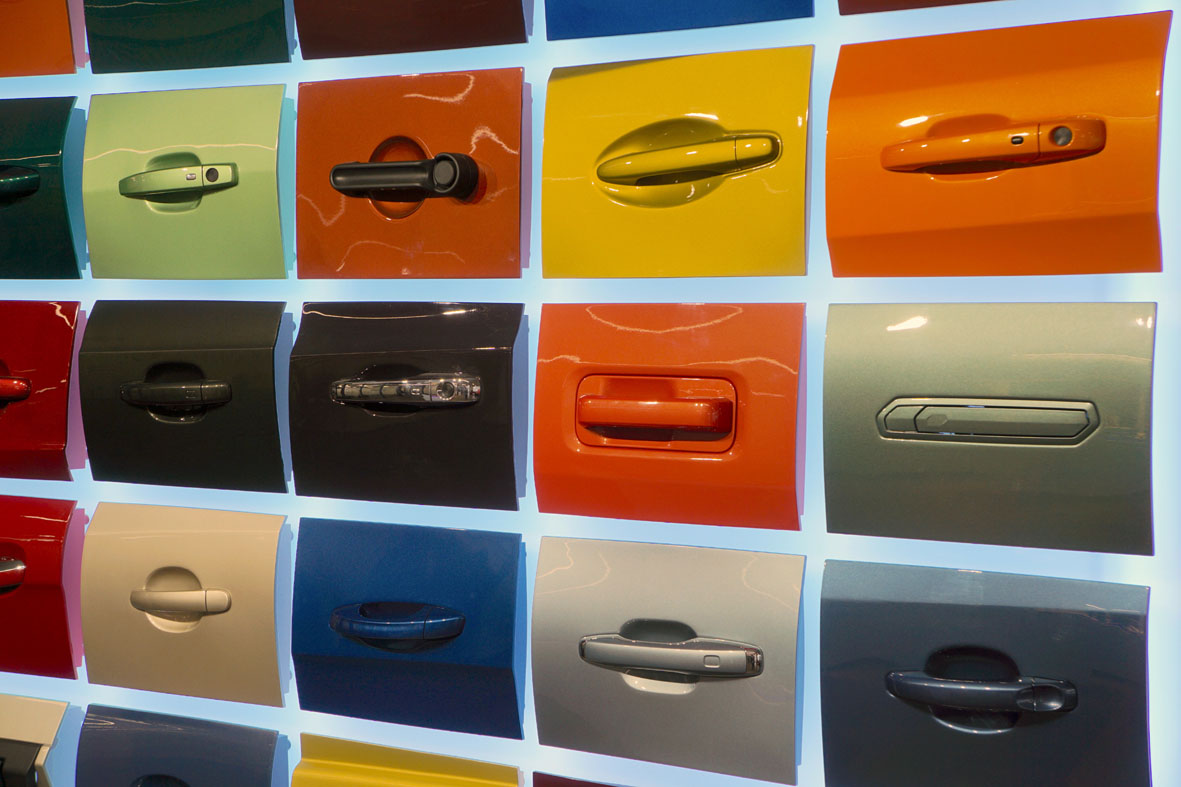
It is simply incredible what has developed from a workshop for the production of suitcase locks founded by Ewald WITTE in Velbert, Germany in 1899 into the company that it is today. WITTE Automotive is still a private, family-run business that achieved a turnover of more than EUR 670 million in 2017 with 5,200 employees in 9 European locations in Germany, Sweden, the Czech Republic and Bulgaria, all with the unaltered focus on “closing and locking”. Today WITTE Automotive is a technological leader in mechatronic closing systems for cars as part of system solutions for doors, hatches, interiors and seats. WITTE Automotive is represented globally in the USA, Mexico, Brazil, India, China, Japan and South Korea as part of VAST, the Vehicle Access Systems Technology alliance. With approximately 12,000 employees and turnover of approximately
USD 1,700 million, VAST is one of the leading global suppliers in this product segment.
The WITTE factory in Ostrov, North Bohemia, Czech Republic, newly opened in 2016, specialises in the manufacture of door handle units and the associated technical modules in a production alliance with the factory in Nejdek, located 20 kilometres away. In Ostrov, the main focus is on plastic injection moulding, lacquering and assembly. One main plant component is the highly automated central system for conveying plastic granulate to the injection moulding machines. It was supplied by the German motan Group and planned and assembled by its Austrian agent Luger GmbH.

The variety of shapes, colours and functions of the exterior door handles and locking units produced by WITTE Automotive Czech plant is impressive. They comply with existing crash safety regulations, are available with and without remote control as well as keyless “Passive Entry/Passive Go” operation and coordinated with the specified car colour of each order (Fig. 1 + 2). The range is completed with the patented “anti-picking” measures. The WITTE Automotive range extends far beyond exterior handles; it also includes strikers, internal door handles, keys and locks, closing aids, door checks and door brakes, door drives and door protect systems.
The range of products for bonnets and hatches is equally comprehensive. In addition to electro-mechanical locks, electrical strikers for motorised hatches or easy-fit handles are used. In particular, the solutions developed for bonnets combine complex exterior contours with a compact and sturdy design. For example, they are part of a concept for an “active” bonnet to increase protection of pedestrians in the event of a collision by using pyrotechnic actuation to raise the bonnet, thereby softening the front crush zone.
A comprehensive range of car seats is also available. “Energy-absorbing backrest latches and strikers minimise the load on the backrest in the event of a crash. They are part of the safety equipment for occupant protection. New seat-to-floor latches for convenient removal and installation of seats as well as the active safety backrest system (ASR) complete the WITTE range,” says David Svoboda, Division Manager Injection Moulding, in his company presentation.
Uncompromising Quality of Plastic Parts
As the door and flap handles of a car are in the field of vision and reach of the user, they make a considerable contribution to the sense of quality of a car thanks to their design and tactile properties.
The handle modules are produced as “car sets”. A set is comprised of all door handles of a vehicle including the functions behind them. For reasons of strength, the structural parts are made of PA6 with 35 per cent fibreglass and the covers of a PC/ABS blend. Only pre-coloured material is used. Production is currently carried out on 12 injection moulding machines and there are definite plans for 10 more (Fig. 3).

Fig. 3: Overall view of injection moulding production, in the foreground work areas for manufacture of the injection-moulded parts
A majority of the handles are produced as hollow bodies using gas injection technology. This requires that in each production cycle a material percentage of 30 to 40 per cent of the injected plastic volume is forced into an overflow cavity, which is subsequently separated, collected and returned to the material flow after shredding. “To aid surface quality, all materials, both virgin material and regrind, must be dried to a residual moisture content of 0.1 to 0.15 per cent (PA6) or 0.02 to 0.05 per cent (PC/ABS),” explains Pavel Karas, Head of Department of Injection Moulding at the Ostrov factory, on a tour of the production department along the material conveyor. “Therefore, we only considered one system layout in which all processed types of plastic, including regrind, quantities are fed to the machines with dry air via a central drying system.”
As much as the drying system is the “heart” of the material supply system in terms of application, the material feed on the injection moulding machine is so easy. A mixing unit was mounted on the machine to mix virgin material with regrind and an additive. Below the dosing unit there is a metal detector in order to separate any knife chips contained in the regrind. For technical details of the machine, please refer to the machine profile below.
Complete Machine Transparently Operable via Master Production Computer
All machine components, with the exception of the dosing units on the injection moulding machines, are activated and operated via the electronic modules specifically developed by motan for this purpose. They are connected to a ControlNet of the central machine control via Ethernet or TCP/IP. This is combined with the comprehensive plant management system LINKnet which collects and records the processes and application data and from which all connected controls up to the device level can be operated. An interface to the existing ERP (Enterprise Resource Planning) system was also implemented.
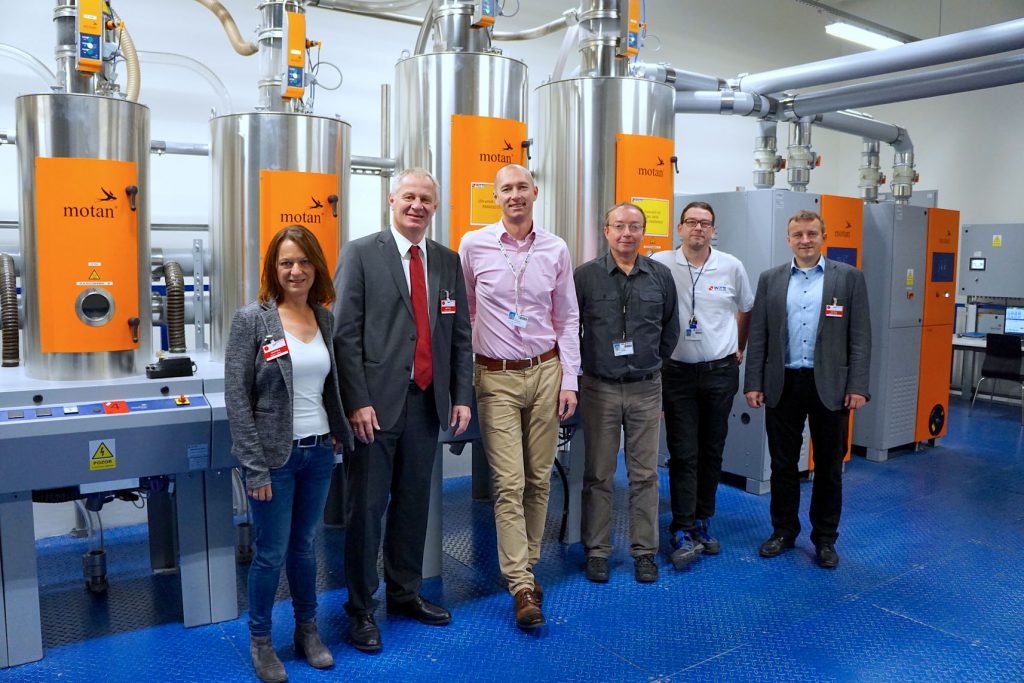
Fig. 4: The project partners motan-colortronic, Luger and WITTE, Czech Republic, look back on successful co-operation. L to R: Carola Wirth, Marketing motan-colortronic, Thomas Luger, Representative motan-colortronic for Czech Republic, David Svoboda, Division Manager Injection Moulding WITTE Czech Republic, Jaroslav Houska, Project Coordinator Injection Moulding, Pavel Karas, Head of Production Injection Moulding at
WITTE-Ostrov and Zdenek Tesar, Sales Representative at Luger Bohemia Region.
Success through Close Partnership
Finally, Head of Division Mr Svoboda, in his resumé at the start of production, summed up the essential criterion for the decision in favour of motan: “In view of the tight schedule for the construction and commissioning of our new production plant, it was important to us to minimise the technical risk for as many system components as possible. After a series of impressive reference visits, we finally decided on motan-colortronic as our system supplier and Luger as our system planner and service partner – and we were not disappointed.” (Fig. 4).
The Machine Profile
Potential for Eight Different Materials on 22 Injection Moulding Machines
PC/ABS blends with and without fibreglass content, PA 6 with 30 per cent fibreglass in consumption quantities of 20 to 100 kg/hr, flexibly distributed over several machines in each case. All materials are fed to the injection moulding machines by the central drying system via dry air conveyance.
Divided Silos for Storage of the Raw Materials
The eight main plastic types are processed away from the silo. Adapted to the consumption quantities, four double silos, each with 2 x 47 m3 capacity, were provided stacked on top of each other for batch separation (Fig. 1a).

Locking mechanisms on the coupling points reduce the potential for incorrect loading. The materials are transported between the silos and the downstream drying system via energy-saving, speed-controlled blowers.

Material Drying
The material types processed at WITTE are dried centrally before being transported to the machines. motan LUXOR dry air dryers of the ETAplus range are used. “ETA” stands for the Greek letter „η“, which denotes the degree of technical efficiency. (At motan, the ETA-process® stands for optimum adjustment of the drying temperature, the dry air quantity supplied, the dew point and the drying time.)
ETAplus combines the temperature adjustment with an additional air volume regulation. The system independently detects fluctuations in material throughput or altered material inlet temperatures in the drying system and automatically adjusts the air volume to the power requirement of the drying bin. In the event of production interruptions, the drying temperature for especially critical materials can be reduced to the standby temperature and thus prevents thermal damage to certain plastics due to overheating. In the event of excessive material throughputs, a visual warning is issued. With ETAplus, energy savings of more than 60 per cent are possible compared with conventional drying systems.
To facilitate adjustment of the drying systems, a material database is installed in the control as an additional function. It contains a basic database with the parameters of approx. 70 standard materials and can also be individually extended with a further 100 data records.

The LUXOR A range with the energy-efficient ETA-process® and ETA plus® drying technology comprises ten models with a dry air capacity of 80 to 2,400 m3/hr. They are equipped with stationary, insulated molecular filter cartridges with separate drying and regeneration processes, which generate a constantly low dew point for the process. All LUXOR A drying systems contain a LUXORnet control and use modern, flexible BUS technology. The system control communicates with the LINKnet master computer system, via which the complete system is monitored and controlled.
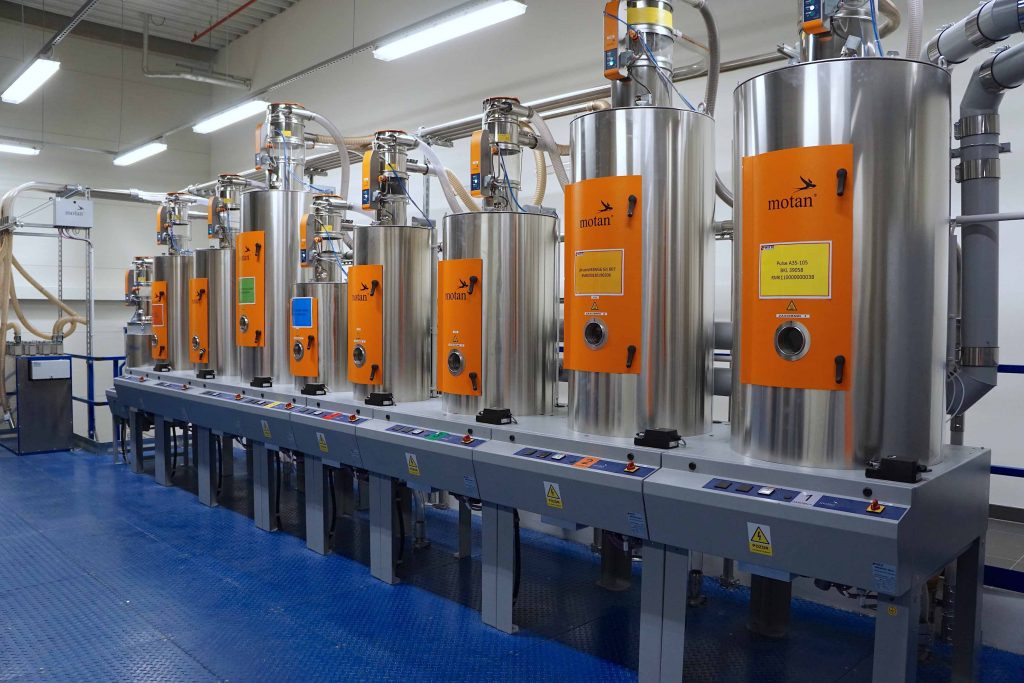
Every LUXOR dryer can be flexibly combined with drying bin volumes from 15 to 2,400 litres. All drying bins are produced as standard in stainless steel, completely insulated and have an individual heater and temperature control. An important feature of the system is the special bin geometry, which influences the material flow through the hopper and thus the drying result due to its height / diameter ratio. “Dead” zones, in which the material could be excessively dried and therefore damaged can be avoided, as can an excessively fast passage of the material through the middle of the bin. Determination of optimum dimensions is based on calculations and practical tests.
METROCONNECT C Coupling System with Encoding
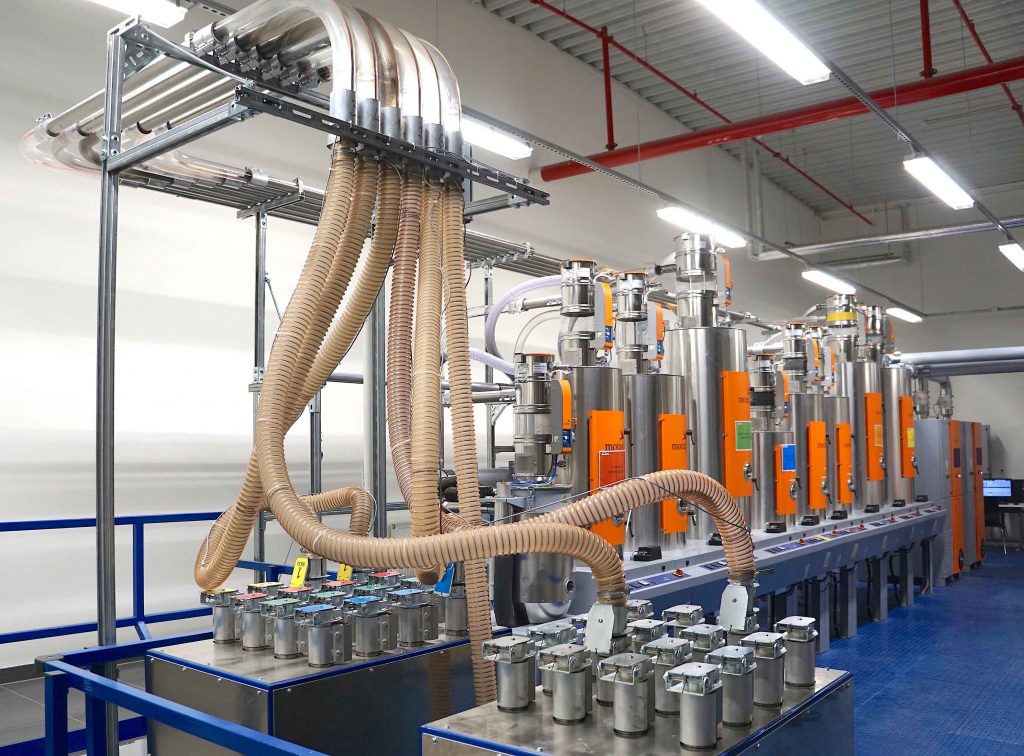
Manually operated coupling table for flexible supply of the processing machines with dried plastic granulate. Poka-yoke is supported here by colour-coding of the coupling pieces and electronic coding plugs.
Conveying
The injection moulding machines are connected to the drying system via a machine-specific material line system (one separate pipeline per machine). The material line is designed for the transport of plastics with a high fibreglass content. For this, the deflection points were designed with wear-resistant glass tube elbows and an outer coating to protect against splintering.
In order to maintain the drying status of the plastic granulate as well as possible up to the injection moulding machines, dry air is used as the conveying medium. In addition, only small material batches are conveyed to the machines and then the lines are completely drained.
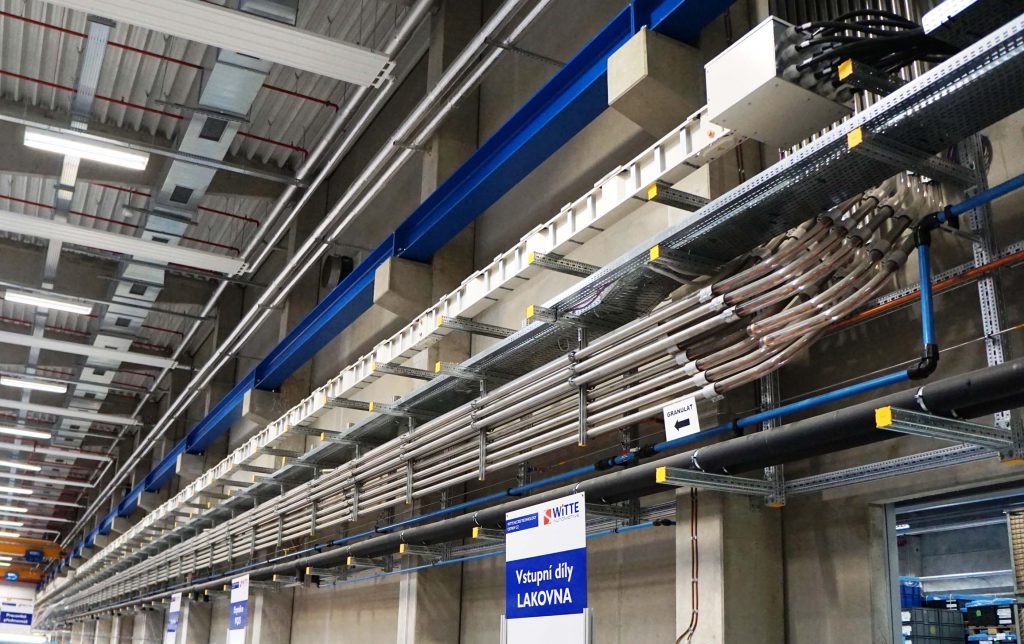
The material line between the drying system and the injection moulding machines, consisting of stainless steel pipes and glass tube elbows.
Material Dosing on the Injection Moulding Machines
All injection moulding machines are equipped with a metal separator and the gravimetric GRAVILCOLOR dosing unit with three metal separators installed on top. New material and regrind are processed on the machines in an adjustable mixing ratio. The third component is an additive.
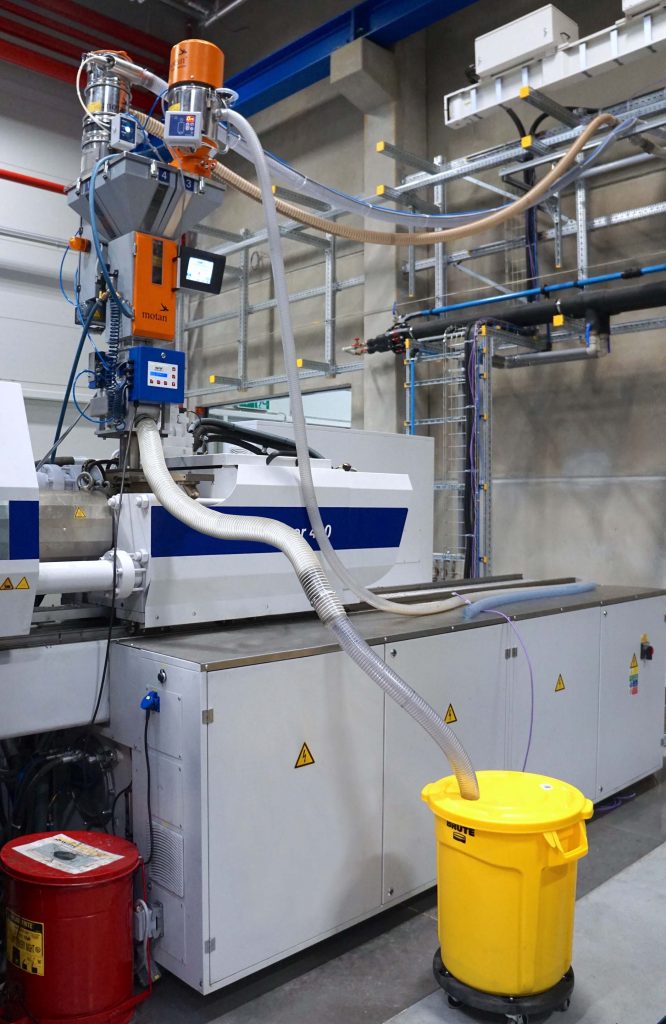
The dosing module on the injection moulding machine in combination with a metal separator (blue intermediate station between the machine and the dosing unit)
Production Master Computer
All machine components are activated and operated via the remote-controlled electronic modules specifically developed by motan for this purpose. The silos, drying system and conveying system are monitored and controlled via the motan CONTROLnet.
The system concept offers potential for further extension up to system management by means of motan LINKnet, to which all motan controls capable of communication can be connected. It enables all process sequences and application data within the motan system to be collected and logged and all connected devices to be operated. With continuous logging of the system processes, processed material batches can be assigned to the products produced and tracked.
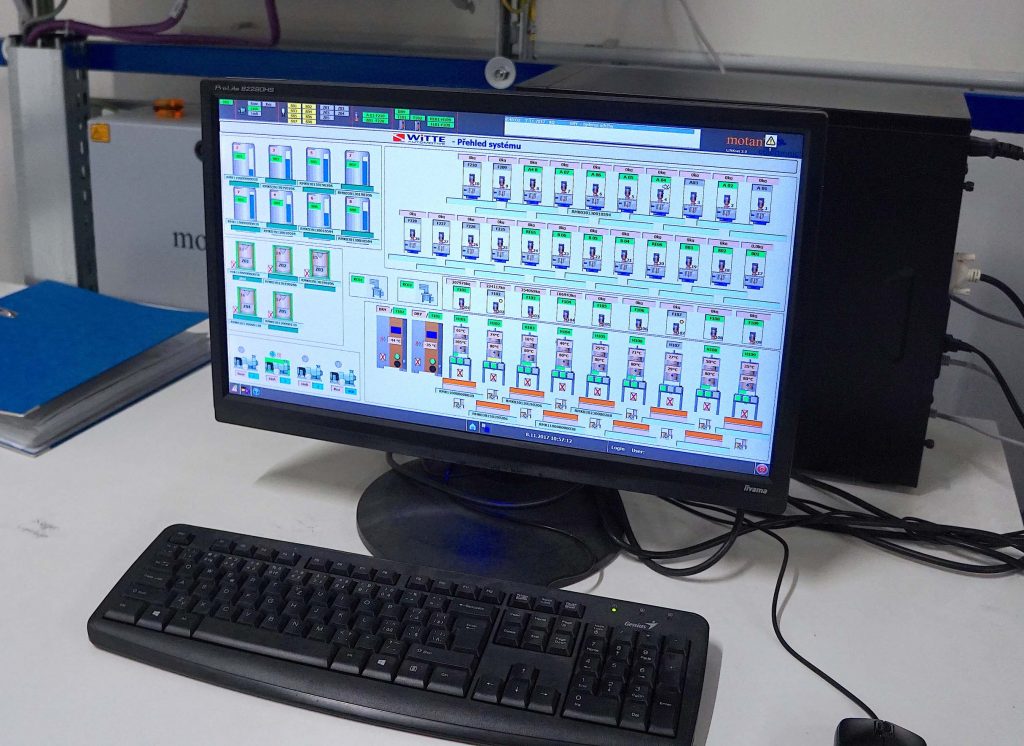
The functions and setting data of the central system are visualised and remotely controlled via motan LINKnet.
Press Release from motan Group
Photos : Reinhard Bauer